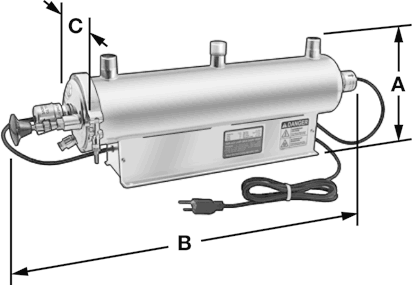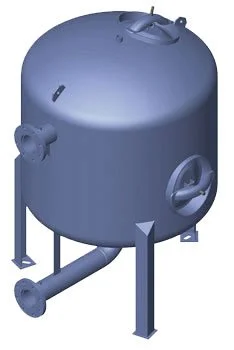
Going Green
Many of our customers are looking for options that are not only cost-effective, but also eco-friendly. Protecting the environment doesn't have to be expensive or less efficient than traditional methods—many of our "green" water treatment options do not require adding chemicals to the water, allowing for cleaner outflow and reduced supply costs, while still delivering excellent results.

Selective Ion Exchange
We Sell Selective Ion Exchange Systems
This technology can alter the supply water chemistry thereby allowing for higher achievable “Cycles of Concentration” (COC). Higher COC’s can lead to dramatic water savings, lower corrosion potential, and lower associated water treatment costs.
How It Works
Ion exchange is an effective, versatile means of conditioning supply waters of all types. The term “ion exchange” describes the process: as water flows through a bed of ion exchange material, undesirable ions are removed and replaced with less objectionable ones. For example, in softening processes, calcium and magnesium ions (hardness) are exchanged for sodium or potassium ions. In dealkalization, the ions contributing to alkalinity (carbonate, bicarbonate, etc.) are removed and replaced with chloride ions. Ion exchange processes are versatile — specific types of ions can be removed from water depending on the choice of exchange material and regenerate used.

UV / Ozone Systems
We Sell UV / Ozone Systems
Ultraviolet light waves and Ozone are proven deadly to microorganisms. The use of this technology can help to minimize microbiological activity in the recirculating water of a cooling tower or closed water loop system.
How It Works
Ultraviolet (UV) ozone generation (via ultraviolet lamps) has been used for decades to generate ozone. The lamps emit UV light at 185 nanometers (nm). Light is measured on a scale called an electromagnetic spectrum and its increments are referred to as nanometers. Air or water (usually ambient) are passed over an ultraviolet lamp, which splits oxygen (O2) molecules in the water or air. The resulting oxygen atoms (O-), seeking stability, attach to other oxygen molecules (either two additional O- or one O2), forming ozone (O3).
Corona Discharge (CD) ozone generation technologies involved in corona discharge ozone generation are varied, but all operate fundamentally by passing dried, oxygen-containing gas through an electrical field. The electrical current causes the “split” in the oxygen. The feature variations are many, but generally they can be divided into three types - low frequency (50 to 100 Hz), medium frequency (100 to 1,000 Hz), and high frequency (1,000 + Hz). Since 85% to 95% of the electrical energy supplied to a corona discharge ozone generator produces heat, some method for heat removal is provided by either air or water.

Sacrificial Anodes
We Sell Sacrificial Anodes
They have played a key role in the protection of residential and commercial water heater tanks, boat propellers, and water storage tanks, just to name a few.
Metal loss (or metal corrosion) occurs by means of Electrolysis. Electrolysis occurs when two dissimilar metals are physically connected in water; one will corrode away to protect the other. Although relatively unknown to most, the principle is extremely common place.
When two metals are placed together in water, the "more noble" (or less reactive) one will remain intact while the more reactive (less noble) one will corrode. When steel and copper are together, steel is the ‘less noble’ metal that will corrode. Magnesium, zinc, and aluminum metals are all less noble than steel or copper, and this is why they are the most common metals used as sacrificial anodes.
How It Works
Sacrificial anodes come in all shapes and sizes (depending on the application). A common shape is a rod (or bar) made of magnesium, zinc or aluminum that's formed around a steel core wire and is grounded to the piece of equipment being protected.
When the sacrificial anode comes into contact with equipment metal (and the water within the equipment), an electrolytic process begins whereby the sacrificial anodes are consumed to protect the equipment metals. Another form of anode “Powered anodes” work similarly, however the sacrificial process is replaced with electricity and the anodes are not consumed.
Metal loss (also know as metal corrosion) occurs by means of Electrolysis. Electrolysis simply means that when two dissimilar metals are physically connected in water, one will corrode away to protect the other. Although few people have heard of this, the principle is extremely common place. All metals fall somewhere on the galvanic scale of reactivity. When two metals are placed together in water, the "more noble" (or less reactive) one will remain intact while the more reactive (less noble) one corrodes. When steel and copper are together, steel will be the ‘less noble’ one that corrodes. Magnesium, zinc, and aluminum metals are less noble than steel or copper, which is why they are most common metals used for sacrificial anode rods.
A sacrificial anode's life depends on the quality of water, the types of dissimilar metals involved, the water temperature, and the size and quantity of the anodes used. Excessively high water minerals (high conductivity) can lead anodes to corrode more quickly.

Specialty Filtration
We Sell Specialty Filtration
How clean is your cooling water? Particles responsible for fouling of heat transfer surfaces are smaller than 5 microns. These particulates can be responsible for increased mineral scaling, increased corrosion via under-deposit corrosion, and increased microbiological fouling. Filtration can help to reduce these particulates and can dramatically improve the performance of your water-using system.
How It Works
Modern day high efficiency filters remove these extremely fine particles to provide the true benefits of clean cooling water. The development of high efficiency sand filters has revolutionized cooling water filtration. Suspended solids can now be cost effectively removed to 1/2 micron with an automatic backwashing filter. Older technology multimedia filters only get down to about 10 microns. Since most cooling water particles are in the 1/2 to 5 micron size range, high efficiency filters are much better at removing these troublesome contaminants. More efficient filtration means greatly improved results with a smaller filter. Our high efficiency filters use ultrafine sand to provide this much more effective filtration. The crossflow action of the water across the surface of the finer media prevents rapid plugging by pushing contaminants over to the storage area. Not only do filtration efficiencies improve dramatically, but the filters require up to 10 times less backwash water for the most “Cost Effective Filtration”






